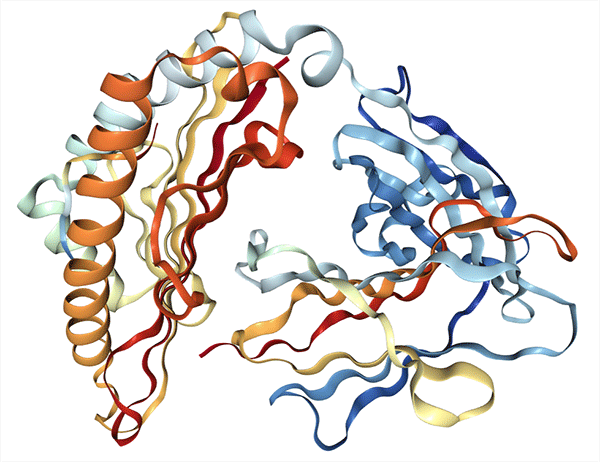Targeting the KRAS G12D Neoantigen to Treat Cancer
, by Jim Hartley
Treating cancers with the patient's own immune system is a hot area of cancer therapy, and relies on the cancer cells being different immunologically from at least most of the normal cells in the body. For treatments based on antibodies that take the brakes off patients' T cells (anti-PD1, anti-PDL1, anti-CTLA4) the immunological differences that result in success or failure, life or death, are usually not known. Since mutant KRAS genes make proteins that are different from the KRAS proteins in normal cells, and since all cells spend part of their time chopping up their proteins and presenting them on their cell surfaces as potential antigens (peptides in complex with HLA molecules), such mutant "neoantigens" may be good targets for immunotherapy. To date, however, "checkpoint inhibitor" and other strategies involving the immune system have not had any success in cancers driven by mutant KRAS genes.
Now in a clinical tour de force grounded in decades of work, Steven Rosenberg and his colleagues at the NCI Clinical Center in Bethesda, Maryland have described how they treated a patient with metastatic colon cancer with immunotherapy directed against the KRAS G12D neoantigen. The cumulative expertise required to develop this personalized therapy is remarkable, as is the story of how the cancer evaded the therapy after a long period of partial response. Briefly summarized:
- The patient presented with ten lung masses, three of which were removed, cut into pieces, and cultured for their tumor-infiltrating lymphocytes (TILs). A total of 24 TIL cultures were derived from the three tumors.
- Exome sequencing of the DNA from the three tumors showed potential driver mutations in 61 genes. DNA segments corresponding to peptides encompassing all 61 mutations were concatenated into 5 minigenes, converted to RNA, and electroporated into the patient's own antigen-presenting cells (APCs). The APCs expressed the minigenes and presented the resulting peptides on their surfaces in complexes with HLA proteins.
- Each of the TIL cultures was grown together with each of the APC cultures (120 co-cultures total) in an ELISPOT format to detect interferon gamma, which indicated activation of T cells in the TIL cultures by peptides presented by the APCs.
- 21 of the 24 TIL cultures responded to at least one of the APC cultures (by secreting interferon gamma). Of the 21, 18 responded most strongly to tandem minigene 1. Tests on each of the peptides in TMG-1 showed that the KRAS G12D peptide was triggering the production of IFN gamma by the TIL cultures. TIL culture #6 was the most strongly reactive.
- TIL culture #6 was expanded and infused into the patient. In the expanded TIL #6 population, 75% of the CD8+ T cells were reactive to KRAS G12D and comprised three major T cell receptors (49%, 19%, and 7% of the total population). These reactive T cells were not detectable in the patient prior to expansion indicating that their normal frequency was less than 2 in 10,000. All the "49%" cells had disappeared by 40 days after the infusion, whereas the "19%" and "7%" cells remained abundant even at 9 months. All the reactive T cells recognized only mutant KRAS, not wild type.
- Of the seven lung lesions present at the time of treatment, six shrank and continued to regress at 9 months, while one progressed and was resected at 9 months.
- The progressing lesion still expressed KRAS G12D, but had lost its copy of the HLA restriction element required for recognition by the KRAS G12D-reactive T cells. This was direct evidence that i) the driver of the tumors was KRAS G12D, and ii) that the mechanism of tumor regression upon treatment was based on recognition of the KRAS G12D neoantigen by activated T cells.
Rosenberg, et al. point out that the combination of the particular HLA allele that presented the KRAS G12D neoantigen, and the prevalence of the KRAS G12D mutation in human cancers, means that thousands of KRAS cancer patients might be treated with TIL-based therapy. While that therapy is very complicated at present, the high percentage of TIL cultures that reacted with the KRAS neoantigen opens the door to further development into a cancer treatment that could be widely used.
